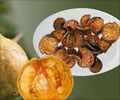In a significant development, an Indian researcher in the University of New South Wales(UNSW) has developed a new technique for extracting a powerful antioxidant from prawn shells.
The antioxidant is called astaxanthin. It’s the pigment which gives cooked prawns their red colour but is almost all contained in the shells and heads thrown away.Antioxidants are substances that may protect cells from the damage caused by unstable molecules known as free radicals. Free radical damage may lead to cancer. Antioxidants interact with and stabilize free radicals and may prevent some of the damage free radicals otherwise might cause. Examples of antioxidants include beta-carotene, lycopene, vitamins C, E, and A, and other substances.
Astaxanthin has long been recognised as being about 10 times stronger than carotene, the more common antioxidant found in many fruits and vegetables.
The technique evolved by Renuka Karuppuswamy to extract astaxanthin from waste prawn heads and shells is efficient enough to make commercial-scale extraction viable, it is acknowledged.
At present most commercial astaxanthin is produced naturally from a particular algae or synthetically by a chemical process. It is used as a health supplement for humans and also extensively in the salmon and egg production industries as an antioxidant and natural food colouring agent. It comes at a price, however, costing around $200 per gram.
Ms Karuppuswamy’s technique raises the possibility of not only accessing a new source of astaxanthin but also finding an environmentally friendly use for thousands of tonnes of prawn waste generated by processing plants globally each year. Australia does little prawn processing at present but that could change as prawn farmers look to “value add” in the future.
Advertisement
Existing methods of extracting prawn pigment rely on evaporating solvents to reclaim the pigment. Ms Karuppuswamy’s technique works at lower temperature, recovers more astaxanthin – around 8mg per kilogram of shells - and causes less degradation during the process.
Advertisement
Karuppuswamy hails from the southern Indian state of Tamil Nadu and is a PhD student of the UNSW Food Science and Technology faculty
Source-Medindia
LIN/P











